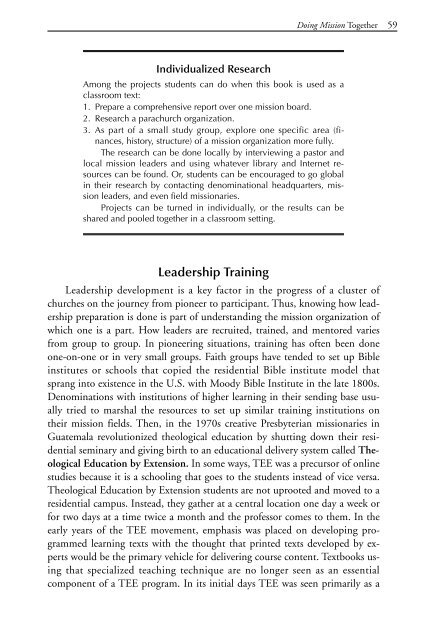discovering missions - Southern Nazarene University
discovering missions - Southern Nazarene University
discovering missions - Southern Nazarene University
You also want an ePaper? Increase the reach of your titles
YUMPU automatically turns print PDFs into web optimized ePapers that Google loves.
245187 Disc Missions ins 9/6/07 1:04 PM Page 59<br />
Individualized Research<br />
Among the projects students can do when this book is used as a<br />
classroom text:<br />
1. Prepare a comprehensive report over one mission board.<br />
2. Research a parachurch organization.<br />
3. As part of a small study group, explore one specific area (finances,<br />
history, structure) of a mission organization more fully.<br />
The research can be done locally by interviewing a pastor and<br />
local mission leaders and using whatever library and Internet resources<br />
can be found. Or, students can be encouraged to go global<br />
in their research by contacting denominational headquarters, mission<br />
leaders, and even field missionaries.<br />
Projects can be turned in individually, or the results can be<br />
shared and pooled together in a classroom setting.<br />
Leadership Training<br />
Doing Mission Together 59<br />
Leadership development is a key factor in the progress of a cluster of<br />
churches on the journey from pioneer to participant. Thus, knowing how leadership<br />
preparation is done is part of understanding the mission organization of<br />
which one is a part. How leaders are recruited, trained, and mentored varies<br />
from group to group. In pioneering situations, training has often been done<br />
one-on-one or in very small groups. Faith groups have tended to set up Bible<br />
institutes or schools that copied the residential Bible institute model that<br />
sprang into existence in the U.S. with Moody Bible Institute in the late 1800s.<br />
Denominations with institutions of higher learning in their sending base usually<br />
tried to marshal the resources to set up similar training institutions on<br />
their mission fields. Then, in the 1970s creative Presbyterian missionaries in<br />
Guatemala revolutionized theological education by shutting down their residential<br />
seminary and giving birth to an educational delivery system called Theological<br />
Education by Extension. In some ways, TEE was a precursor of online<br />
studies because it is a schooling that goes to the students instead of vice versa.<br />
Theological Education by Extension students are not uprooted and moved to a<br />
residential campus. Instead, they gather at a central location one day a week or<br />
for two days at a time twice a month and the professor comes to them. In the<br />
early years of the TEE movement, emphasis was placed on developing programmed<br />
learning texts with the thought that printed texts developed by experts<br />
would be the primary vehicle for delivering course content. Textbooks using<br />
that specialized teaching technique are no longer seen as an essential<br />
component of a TEE program. In its initial days TEE was seen primarily as a

















